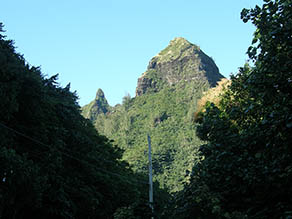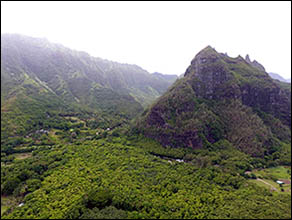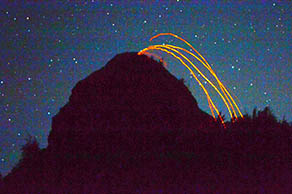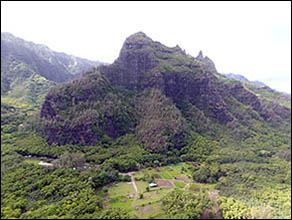 |
 |
 |
 |
||||||
|
|
|
|
|
|
|
|
|
|
|
|
|
|||||||||
 |

Makana Mountain is famous for being one of very few places in the Hawaiian Islands where the art of fire throwing (‘ō ahi) was performed. Henry Kekahuna links this activity specifically with graduation ceremonies for ali‘i at the hula seminary. Certainly it was a very special occasion and not one undertaken lightly. Here is his description:
"Far less pretentious were the hula graduations of classes of commoners composed of commoners exclusively. Feasting and hula would be enjoyed for about ten days, their fire throwing, if any, was limited to the local cliff of Makana only. "Nowhere was fire-throwing more popular than on the island of Kaua‘i. There it was the spectacular sport of kings and chiefs on outstanding occasions. Blazing shafts of light wood, hau and papala, dried from six to eight months, would be cast seaward from the heights to be born about by the wind, presenting brilliant displays." Pāpala was the favorite wood for fire throwing. Chipper explains that this plant is not to be confused with the papala kepau, which is different. "Pāpala is in the amaranth family, produces a very light, flammable wood when its dry, and has a hollow pith, a hollow core, so they said that often they would just light one end and throw it like a spear, and the flames would travel through the hollow core and out the back, and would look like a jet rocket flying through the night. Other times, they would throw it so it would tumble, and would look like a fireball tumbling off the cliff. Must have been incredible to see that!" 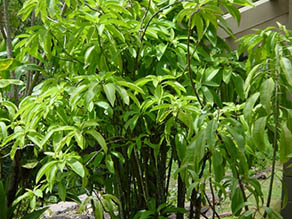
Beatrice H. Kraus, in her work "Plants in Hawaiian Culture" (1993: 95-6) writes that ‘ō ahi was a sport carried on during certain times of the year when strong winds swept out to sea from the high cliffs on the Na Pali coast on Kaua‘i. She adds that "Some of the embers dropped into the sea; others were intercepted by some of the spectators in canoes in the sea below the cliffs and used to brand themselves as a form of tattooing to commemorate the occasion." Samson told us a little about trying to recreate fire throwing back in the 1980s. First of all, he said, "I went looking for the pāpala wood. Well, it might have been common a hundred years ago, but you think I could find any now?" Then, he said his mother warned him about the climb. "She said, you got to go a little, then stop, wait, because of the wind." In the end, he did not go through with it. “My Dad is not one guy who tell anything about himself," Samson continues, "but I know my Dad went up there. I got my information from my Dad. When he doesn’t want you to go, he’ll just stand mute. Because it’s too dangerous. But everybody, for their kids, they’re going to look like that. They’re not going to take the keys and tell them, ‘You look for telltale signs if you can or no.’ Or you get one place if you take them, ‘That’s not for you, can’t go anyplace.’ I mean that’s what I would do. “I wouldn’t tell them nothing but ‘Oh, let’s go up here.’ So you can know they can stand heights, they’re not afraid. With that they’re not bad, then you fool around, tell them more. But otherwise you wasting your time. Because you’d be more problem than anything. Just don’t have it, not everybody can stand heights. "And then up there where you go, there’s no place else. You look back toward Limahuli valley here. If you look back this way, there’s nothing, you cannot see the wall, there’s no more. Visibly you cannot see your height and your position. It’s straight, it’s not concave. It’s out of the picture. So if you cannot stand heights, you look back, you might freeze." “My nephew and his kids went up there. Moku is my sister’s son, she married Francis Chandler. And that’s her kids. But we talk story. I just tell them how it was then. She just looked over the manner of speech they’re comfortable and they’re smiling. She looking at me because you got to look the right direction or else you get into problem, yeah? 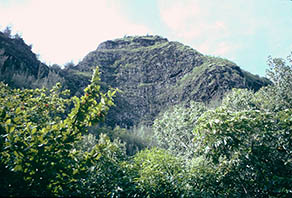
"You need guys that can stand heights, so I can’t go with you. Talk story, see physically how they grip and how they balance, how their eyesight. Because the only way it’s coming is what you can see. What you cannot see, you going to be feeling, instinct. You got it, or if not…. You got to use everything you get for be safe. This is to offer anybody would want to challenge anything: Don’t go cause somebody else trouble. “If you’re going to do stuff, you got make sure you get what you need, make sure who come with you, you know them well. Then no problem, yeah. Everybody get their own way to communicate, by presence, tilt of the head, the way you move. Because anybody know you know when you get excited, you jerk or you flinch, or stuff like that. There are a lot of telltale signs. For me, anybody going with me, they got to be calm, but at the appropriate time. You get plenty of ways to test guys. For me, I got to see the normal reaction.” "It's a critical climb up there," Chipper affirms, "really critical. It was definitely a life and death climb to get up there, it wasn't for the faint-hearted. Tradition had it that they would come back down the next morning after it became light. But who knows? It wouldn't have been too comfortable of a place. The cliff is such that the wind just whistles right up the face. And if you step back a little ways from the front, you're kind of in the lee of it, it's not too bad. There's nobody left alive that has any first-hand knowledge of that at this point." “Any kind of Hawaiian stuff got protocol,” Uncle Tom warns. “And you got to do it right because if you’re doing something wrong you’re going to get it. Anyone go out there and try to make that fireworks. It’s not going to work, must get protocol. And at that time they had the people for that. They would tell you when. Not you yourself go up there and just go throw that stuff down. You’re lucky you don’t burn all this pali! “I don’t want to do stuff like that. No go fool around that kine because you can get burned. Because you know what? This place over here, the spirit is alive yet, this place, all around here. In fact, in the islands, that thing is alive." The last historic occasion of fire-throwing occurred in celebration of the visit of Queen Emma. Why did they stop? Chipper suggests that "For their ali'i, they did it. When Queen Emma came, they did it. Samson's father or grandfather was in the last bunch that did that. It was considered a very sacred ceremony, not something that was done just for the heck of it, so maybe as the ceremonial function began to cease, along with that, a lot of the motivation." More recently, a descendent of one of the traditional families took it upon himself to bring back the tradition of 'ō ahi. "That whole relationship between the people, and their gods, and their chiefs, changed so rapidly," Chipper sighs. "The Kamehamehas were able to maintain that kind of reverence from their people, but after the fall of the monarchy, it was a whole new world out there in terms of what's important. As they say, aloha died and cash took over."
|
 |
|||||||

|
|
||||
Copyright 2018 Pacific Worlds & Associates • Usage Policy • Webmaster |
||||
